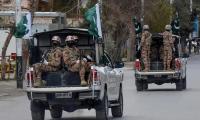Businesses in Pakistan faced some ‘unforeseeable circumstances’ due to the disruptions caused by the Covid-19 pandemic. This unfortunate reality calls for tough discussions regarding business operations. The country needs a timely debate on a significant reduction in regulatory costs for businesses.
Financial support and facilitation provided by the government amid the pandemic were not sufficient for all sectors – especially the private sector. Going forward, experts also predict that the evolving situation in Afghanistan is bound to have an impact on the business climate in Pakistan, especially in Khyber Pakhtunkhwa (KP), which shares the border with Afghanistan. Also, global supply chain disruptions and rising inflation are not going away until at least mid-2022.
It is essential to learn the lessons from 2021 so that we can come up with more innovative approaches for the year 2022; the aim is to cut down the cost of doing business in KP and attract lucrative foreign investments. This calls for a look at some of the major trends and shortcomings across the province.
The KP government is focusing on setting up economic zones, which will hinge the way forward for business development. But over the past three years, city-level taxes, charges, levies, and other forms of payment have increased the cost of doing business in KP, cancelling the impact of some business-friendly policy measures introduced by the government.
However, with investment-friendly policies of the provincial government and efforts of the Khyber Pakhtunkhwa Economic Zones Development and Management Company (KPEZDMC) and the Khyber Pakhtunkhwa Board of Investment and Trade (KPBoIT), the province has started to offer some hope to the business community. These institutions are attracting foreign and local investments across the country and focusing on the growth of the province as a land of opportunities. The provincial government needs to focus more on certain barriers that can be addressed through legislative, regulatory and policy actions. Innovative technological needs have arisen in the province, where regulators have to reform and modernise in line with international practices for inclusion in the global value chain.
Second, the growth of the informal economy due to indirect incentives is not part of the tax net. This leads to competitive advantages of direct and indirect costs, enabling small firms to remain informal. The private sector is stagnant with no growth. The post-pandemic facilitation by the government is welcoming, but it is not accessible to relevant stakeholders as the State Bank of Pakistan assessment on the tax bracket is questionable, where support to small and medium enterprises (SMEs) is limited to banking infrastructure.
The automation part is being addressed in collaboration with the public-private partnership for startups, where national incubation centres are supporting them in uplifting as an integral part of the country’s GDP. The ultimate solution lies in communication and coordination which should be stronger and more transparent.
Third, comparative advantages of various districts in KP are vast and different as CPEC and the Afghan transit trade have opened new avenues of business and investment. The major gap identified in the Afghanistan market is regional connectivity, and its solution lies with government departments working in collaboration with the private sector. Much focus should be directed towards the current economic policy framework as there is a need to focus on district-level or city-level business reform strategies.
Fourth, the backbone of the economy should be on industrial coordination with an objective of one window and a high ease of doing business level. Historically, an industrial policy is not suitable or effective. The previous policy was subjected to various implementation issues. However, there are hopes affiliated with the 2020 KP industrial policy. Local industries should be supported in terms of regulations. Long-term goals should be effective and result-oriented, but, at present, focus should be given to short-term goals with a motive for sustainability. Solution-based mechanisms and proposals of coordination are needed. Business associations and chambers of commerce can play a pivotal role in this regard.
Fifth, the agenda of the single window should be to address the issues related to transit and trade. The focus of Pakistan Single Window (PSW) is on ease of doing business, where 75 departments are being connected to PSW comprising the majority of federal departments. The export side of KP has issues of logistics and security while on the automation side, work is in progress. Transit routes are nationally being aligned in a manner where the exports sector issues are being addressed. The tax side of the provinces requires a stern hand solution with a single invoice, leading to a better regulatory environment.
Sixth, extensive research is required by engaging think tanks, academia, civil society and the private sector with a single objective of discussing and thinking on the regulatory aspect of ease of doing business. Research can create immense support for the business community by shedding light on sub-provincial business reforms. The recommendations should be floored to the government for creating a passage for ease of doing business. These steps can be pivoted to the way forward for bridging policy gaps between the industry and the research body of the government, resulting in an uplift of the regulatory mechanism.
For an effective and everlasting impact, a research-based economic policy should be implemented in the country, and for this purpose, public-private coordination is important. Policy and academic research should focus on identifying missing links and loopholes for regulators. It will enhance the level of ease of doing business at the provincial level.
The writer is a researcher associated with the Centre for Private Sector Engagement at the Sustainable Development Policy Institute (SDPI).
MPAs ask for their salaries and benefits to be at par with high court judges and exempt from tax
This system fosters and places premium on VIPs, facilitating VIP culture, which is alive and kicking
Imagine this waste covering over 15,500 cricket stadiums, piled three meters deep every year
If there is one thing that can be gleaned from politics today, it is that we no longer speak same language
Postman argues that “typographic mind” was yielding to “televisual mind”
Pakistan is well poised to meet opportunities that Artificial Intelligence will offer for developments in industries







